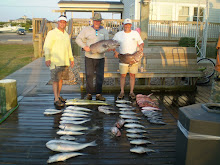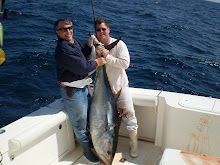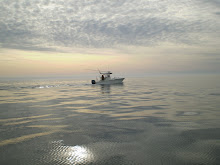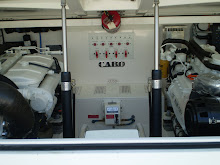
By Jim Field
The other day the fishing regulators published updated guidelines for fishing with "greenstick" gear, specifically, fishing for Atlantic Highly Migratory Species (HMS). This caught my eye for several reasons: (1) because the Crew regularly talks about greenstick fishing (2) we see boats fitted out with greeensticks off Hatteras, and (3) I wasn't aware there were regulations governing greenstick fishing.
Looking into greenstick fishing on the web, I came across a couple of very interesting articles from local VA and NC newspapers, penned in the 1990s and early 2000s, about how this gear/technique found its way to Hatteras and its origins in the Pacific. Furthermore, I found images posted on the web showing different types of birds and rig configurations. So today here is the content I've cobbled together: diagram, regulations, local articles, photos. Pretty cool stuff. Maybe we should install one on the Sea Ya Bea? I'm game. Why not?
How It Works--A Basic Schematic

The simple explanation is as follows: you've got a 45 foot high greenstick; a mainline consisting of 800 to 1,000 pound test monofilament running about 1,000 feet aft, so wayback; a large bird on the end to provide tension and create "noise"; then off the mainline there are multiple hooks with plastic squid skirts. The hooks dangle from the mainline and swim/dance across the water. (Now I see how kite fishing is a derivative of this.) In the case of charter boats, when a fish hooks up, the line breaks off the mainline and you fight the fish on a dedicated rod/reel.
The Newly-Updated Regulations
This notice describes the authorized use of green-stick gear in Atlantic Highly Migratory Species (HMS) fisheries. Green-stick gear is defined as an actively trolled mainline attached to a vessel and elevated or suspended above the surface of the water with no more than 10 hooks or gangions attached to the mainline. The suspended line, attached gangions and/or hooks, and catch may be retrieved collectively by hand or mechanical means. Green-stick does not constitute a pelagic longline or a bottom longline as defined in this section or as described at § 635.21(c) or § 635.21(d), respectively. Green-stick gear may be used to harvest bigeye, albacore, yellowfin, and skipjack tunas (BAYS tunas) and bluefin tuna aboard Atlantic Tunas General, HMS Charter/Headboat, and Atlantic Tunas Longline permitted vessels.
Onboard Atlantic Tunas Longline permitted vessels, up to 20 J-hooks may be possessed for use with green-stick gear and no more than 10 J-hooks may be used with a single green-stick gear. J-hooks may not be used with pelagic longline (PLL) gear and no J-hooks may be possessed onboard a PLL vessel unless green-stick gear is also onboard. J-hooks possessed and used onboard PLL vessels may be no smaller than 1.5 inch (38.1 mm) when measured in a straight line over the longest distance from the eye to any other part of the hook. Atlantic HMS Angling permitted (recreational) vessels are not authorized to use green-stick gear as defined above. HMS Angling permitted vessels may use handgear configured as a vertical outrigger with a fiberglass pole (such as the pole used with green-stick gear) and the line from a rod and reel linked to the main line with an outrigger clip or other break-away attachment. When
a fish strikes, the rod and reel line breaks away from the main line, leaving the fish attached only to the rod and reel. Then, the fish is fought individually and landed using the rod and reel.
Local Article #1
GEAR REVOLUTIONIZES TUNA FISHING--OUTER BANKS FISHERMEN USING "GREEN STICKS" HAVE SEEN AS MUCH AS A 15-FOLD INCREASE IN THEIR DAILY CATCH
DREW C. WILSON/The Virginian-Pilot
For more than a century, tuna-catching technology hadn't changed much. Watermen traditionally set long lines, trolled baits on rods and reels or harvested the popular fish with hand lines.
This winter, however, a 45-foot fiberglass pole is revolutionizing the way Wanchese watermen work - and, in some cases, helping them catch 15 times more tuna on a trip.
Charter captains, anxious to increase their fee-paying anglers' hauls, also are getting on the stick. Three Oregon Inlet-based boats already have bought the new gear to test during this spring's sportfishing season. Owners of at least eight other Outer Banks vessels have ordered ``green sticks'' in hopes of cashing in on increased catches.
Some say the innovative device developed by Japanese fishermen more than a decade ago soon could change the East Coast's entire commercial tuna industry.
``A few of the other guys had 'em out there last year. And they were getting big bites when no one else was,'' said charter boat captain Paul Spencer, who runs ``The Sizzler'' out of Oregon Inlet Fishing Center. ``Their catches were a whole lot better. I was real impressed with the way it worked. I want to have it for my parties, too.''
Manufactured only in Japan, green sticks have been used in the Pacific since the early 1980s. Wanchese waterman Charles Midgett first saw the stick in 1986 while vacationing in Hawaii. He spent the next 10 years fine-tuning the technology - and perfecting pieces of the radical rig.
``I couldn't get one over here. So I tried to build my own. But it just didn't work right,'' Midgett, 70, said from his Roanoke Island home. ``A guy from Florida had a stick I finally got ahold of. But he didn't have no bird. So I made one.
``It took us awhile to get this right,'' Midgett said. ``But now I think we've got it mastered.''
The stick itself is 34 to 45 feet long, made of fiberglass, with a metal eye at its tip. It's extremely flexible, comes in three or four sections, and can telescope down to about one-third of its full length. Most sticks weigh less than 150 pounds. In the United States, they sell for $1,950 to $2,900 each. Captains mount these poles to their boat's deck, and usually brace them on top of the cabin.
Although the gear's commercial name is green stick for the original olive tone, Midgett's son, Butch, who runs Etheridge Fishing Supply Co. in Wanchese, said he's sold black, lavender and blue sticks. Last week, he finally got some of the olive variety in stock. Of the 10 he just ordered, eight already are spoken for.
``These sticks get tuna strikes when, a lot of times, nothing else will. They're much better for catching 50- to 100-pound fish,'' Butch Midgett said. ``They're not magic sticks, though. You still gotta be a good fisherman to make them work. It's a very complicated piece of material.
``But people who know how to use them right really are able to produce with them.''
Unlike other tuna fishing methods, which troll bait beneath the surface, green sticks let lures skip above the ocean.
A main line 1,000 feet or longer, made of 800- to 1,000-pound-test monofilament, is attached to the stick with a cotton strand breakaway line. With leader lines, five to seven lures or baits are snapped to the main line.
Each leader is a different length so as the main line angles closer to the water the baits just skip across the surface. The baits are about 35 to 45 feet apart, depending on the length of the stick. A ``bird'' is attached to the end of the main line and drags up to 600 feet behind the boat.
``The bird is a key component of the rig - and that's what Mr. Midgett really perfected,'' said Wayne Wescott, an official with North Carolina State University's Sea Grant program who helped Wanchese watermen research and revise the green stick design. ``If any one person in North Carolina can be credited with bringing this new technology to town, it's Charles Midgett. I don't know where the idea originally came from. It's a very unusual, creative design.
``I think it's the most innovative gear I've seen - and it certainly will help the commercial fishermen.''
Made of two pieces of spruce that Charles Midgett glues together in his backyard, the birds really look more like primitive porpoises painted white, with red eyes and mouths. They're about 3.5 feet long, weigh 18 pounds each, and include two angled ``wings'' made from molded heavy duty aluminum that help the bird move up and down in the ocean. The primary purpose of the ``bird'' is to hold the main line taut behind the boat, so the baits dance just above the surface.
Midgett said they also serve a second purpose: attracting the tuna who think another predator is trying to get its food.
``The bait acts like a flying fish, jumping just above the water and skipping across the waves. The tuna think the porpoise-bird is chasing those fish. So they come after them so the other animals don't get the bait first,'' Midgett said.
Wescott said the situation is similar to a family dog, who leaves food in its bowl until another dog comes along. Then, that first dog will eat all the food - even if it's not hungry - just to keep the second one from eating out of its bowl.
``I've seen those tuna jump higher than my house to get at the bait,'' Midgett said. ``They just vault out of the water, trying to beat the porpoise to the punch. It's really an exciting, amazing sight.''
The bird also creates a commotion splashing behind the boat, which may help attract tuna, too.
``You can pull a plastic squid right over the water and get 20 hits as soon as it's out there - while a ballyhoo bait right beneath the water won't even get a bite,'' said Chucky Midgett, Charles' 39-year-old son who has used the green stick commercially more than any other East Coast waterman. ``I used to have to do a whole lot more scouting around for fish. Now, I don't have to look for them much. The fish sometimes seem to find me.
``With the stick, I can catch yellow fin and big eye tuna when I never would've got 'em before - as many as 72 on a daylong trip. There weren't many days last year when any other commercial boat caught more fish than I did,'' said Chucky Midgett, who runs his 36-foot boat with one other fisherman. ``I paid for that $3,000 stick with only one day of fishing it.''
Plastic squid 6- to 18-inches long with fluorescent specks and ballyhoo seem to work best as green stick bait, watermen said. Hook sizes vary. But No. 45, 50, 54 and 55 hooks all have been successful.
Commercial crews use a hydraulic reel mounted to the boat's back deck to haul in the tuna. The cotton strands break when fish strike. Then the reel starts working.
Recreational anglers have to bring in their own fish, however, if they want to be considered for International Game Fish Association citations. So Wescott, Charles and Chucky Midgett helped configure a special break-away design for the charter boats' green sticks. Each of the seven hooks is attached to its own leader, which is linked to the main line with a snap swivel and rubber band. When a fish strikes, the rubber band breaks off the main line, leaving the leader attached only to a regulation rod and reel. Then, anglers can fight the fish themselves and bring them in by hand.
``On the commercial boats, even big fish hardly fight at all,'' Wescott said. ``There's pull from the bird behind. There's pull from the hydraulic reel ahead. The tuna don't know which way to turn. That way, watermen get a much better quality fish to sell. The tuna are caught so quickly, they don't get tired in the struggle.''
Charles Midgett said that when he and Chucky first started experimenting with the green stick, ``The other commercial guys wondered why we were bothering - and the charter boat captains laughed at us.
``But those boys kept seeing Chucky catch more fish than them - sometimes, as much as 15 times more tuna. Soon, they caught on. Now, everyone wants to get on the stick.''
Local Article #2 (or a reference citation from somewhere?)
NOAA Fisheries has become aware that one unclassified gear type, referred to as the "green stick rig", may be being used by fishermen to target Atlantic HMS with increasing frequency and success. Green stick fishing gear has been used in other parts of the world for many years. The green stick technology made its U.S. debut in Hawaii during the 1980's but was originally developed in Japan. The term green stick refers to a certain brand of gear developed in Japan that used an olive green pole. Other brands have marketed gears with poles in orange, black, and blue, but regardless of the brand or color, the generic "green stick" nickname is still used. The green stick fishing rig is a gear that is used primarily to target tunas Wescott, 1996).
Wanchese Green Stick Draws Renewed Interest
Winter 2002
Wayne Wescott was not surprised when he received a call from a Costa Rican angler. The man asked what he knows about the Wanchese Green Stick Tuna Rig.
He came to the right person. Wescott, Sea Grant fisheries specialist, replied, "At $6,000 a rig, commercial fishermen tell me it's a worthwhile investment."
And for good reason. In a good year, sushi-quality bluefin tuna could bring top market price of $60 to $90 a pound. In 2000, combined tuna landings in North Carolina amounted to $3.4 million – more than double the five-year average. The appearance of the prized bluefin off the coast before the coastwide quota was reached contributed to the success.
The 2001 season won't match that, says Capt. Fred Fox of Wanchese since the season was cut off Nov. 30 before "the big blues" ever arrived. Nonetheless, Fox is sticking with the green stick tuna rig to reel in bigeye and yellowfin tunas, which bring better than average market prices.
Fox, like most North Carolina commercial fishers, got started with the green stick tuna rig thanks to Chuck Midgett of Wanchese.
Back in the mid-1980s, Midgett asked Sea Grant to help him find information about the green stick rig he had seen in Hawaii. The term green stick refers to a commercial brand of gear developed in Japan – still the only source for the novel gear regardless of color or brand.
Midgett installed the rig on his son's commercial fishing boat and the pair began experimenting to compare the green stick and conventional gear when the yellowfin tuna began running in 1995. His catch averaged three times greater with the green stick rig. Surprisingly, the tuna struck the artificial squid lures and ignored the bait being trolled on his rods and reels.
Midgett and Wescott conducted workshops to spread the word among local watermen. Since then, about 150 commercial fishers have followed Midgett's lead. Each one puts his or her own spin on the rig. Wescott says the basic configuration may vary, but the approach is the same:
A 35-foot fiberglass pole is mounted inside the boat. A 500-foot line originating from a spool at the stern is hoisted by a tether rope at the top of the pole. A cotton breakaway connects the tether rope to the main line.
A floating decoy called a "bird" is attached to the end of the main line. When the boat moves forward, the top of the mainline is stretched taut. Several baited strands hang from the mainline and dangle just above the water, causing the attached lures and bait to skip across the surface.
Meanwhile, the bird jumps, bobs and splashes. The tuna leaps to take the bait when they are not "feeding" on traditional gear in the same vicintiy, Wescott says.
For detailed information and diagrams on using the green stick, order "The Wanchese Green Stick Tuna Rig" from Sea Grant. Ask for UNC-SG-96-04. Call 919/515-2454.
Photographs Off the Web
A hand-crafted bird that appears nicely-engineered

Painted to look like mahi-mahi (?) or tuna (?)










How fast were you dragging this "bird"?
ReplyDelete